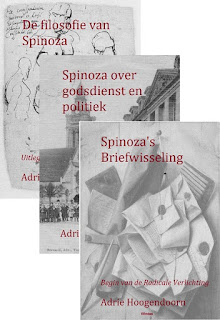Wipslijpbank in het Spinozahuis geeft verkeerd beeld van Spinoza's lenzenslijpen
Twee weken geleden plaatste ik op dit weblog een verzoek om informatie over de houten draaibank in het Spinozahuis. Ik deed dit op verzoek van Kevin, een optica-deskundige die op een werkelijk indrukwekkende wijze onderzoek doet naar wat er te vinden is over Spinoza's lenzen slijpen. [Zie hier zijn weblog]

Daarop heb ik geen reacties gekregen. Vandaag ontdekte ik in het Spinozanummer van Bzzlletin van dec. 1984 een verhaal van Guido van Suchtelen, vroegere secretaris van de Vereniging Het Spinozahuis, over de herkomst van dat apparaat.
 En daaruit blijkt overduidelijk dat dit apparaat helemaal niets met Spinoza van doen heeft. Uit alles wat ik inmiddels heb kunnen lezen op het weblog waarop Kevin van zijn naspeuringen verslag doet, begrijp ik dat dit 19e eeuwse apparaat totaal niets met de door Spinoza gebruikte techniek van doen heeft.
En daaruit blijkt overduidelijk dat dit apparaat helemaal niets met Spinoza van doen heeft. Uit alles wat ik inmiddels heb kunnen lezen op het weblog waarop Kevin van zijn naspeuringen verslag doet, begrijp ik dat dit 19e eeuwse apparaat totaal niets met de door Spinoza gebruikte techniek van doen heeft.
De curator van het museum 'Het Spinozahuis' in Rijnsburg zet hiermee het publiek en blijkbaar ook deskundigen op een vereerd been. Ik stel voor dat, wanneer straks in september het Spinozahuis weer wordt opengesteld, dit apparaat niet meer wordt teruggeplaatst of eventueel wordt vervangen door iets dat dichter in de buurt van Spinoza komt.
Ik plaats hier het gedeelte uit het artikel van Van Suchtelen over die slijpbank.
 [
[

Reacties
I loved what you have said about the lathe. This is wonder research. And I do question why the Spinoza house has not been more forthcoming about the nature of its exhibit. But if you are recommending that the lathe be removed from the Spinozahuis in September I’m not sure that that is a good idea. First of all, the lathe gives a strong sense that Spinoza himself worked at lens-grinding. It creates an impact that is important. One should only take it out if there was another that would replace it (which really would may not be more authentic unless it was modeled on an image from Hevelius for instance, still only a guess). Secondly, the lathe there has become a bit iconic. It forms a large part of the visual memory of the house for those that have been there over the years. An empty room would not do. The big problem is that it is not properly labeled. One should simply know that this is a 19th century woodturner’s lathe, just meant to give a general idea, an impression. Lathes in the 19th century had not progressed much from the lathes of the 17th century, and it seems likely that Spinoza used a lathe that was fairly simple in design. (The semi-automatizing “improvements” of savants like Christiaan Huygens were not necessarily seen as improvements by Spinoza: see Letter 32). The odd thing is that the story you have uncovered is a fascinating one. It reveals the texture of the Spinozahuis itself, its living history, the way that history is made. A museum simply does not exist “sub specie aeternitatis”. Revealing how the lathe got there, and acknowledging its role in the living history of the museum would actually direct our attention to some of the more important features about a house trying to keep the memory of Spinoza alive, that history is an effort and a narrative. The important thing is for the exhibit to be clear, and when it is not clear, accurate, I would think.
With the 400 year anniversary of the telescope coming to Middelburg in September, this would be a natural time to emphasize and the Spinozahuis lathe’s history, and to organize additional information around the piece letting others become more aware of Spinoza’s commitments to optics, not a small portion of his life.
Kevin 23-07-2008 @ 19:48
De plaats waar zich het Spinozahuis bevindt is niet Rijnsdijk, maar Rijnsburg. Misschien nuttig om te weten voor diegenen die het Spinozahuis nog niet kennen.
Vriendelijke groet,
Ben.
B.C.Santen 28-07-2008 @ 09:47
Beste Ben,
Bedankt voor de correctie. Merkwaardig hoe ik zo´n vergissing kon maken. Natuurlijk weet ik dat het Rijnsburg is. Maar ik heb in mij jonge tijd aan de Rijndijk in Voorschoten gewoond en zo sluipt zo´n vergissing erin. Ik verander het in de tekst zelf, maar laat deze opmerkingen staan.
Stan 01-08-2008 @ 18:11
Was Spinoza ook een diamantslijper? Gisteren stond dat in de virtuele krant van Het Parool en bij het Spinoza monument bij de Stopera wordt de diamant als symbool gezien voor zijn gedachtengoed..
Kees Eskes 20-11-2008 @ 11:27